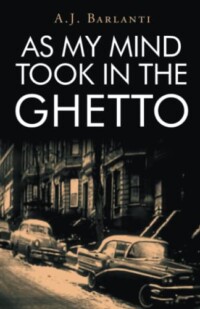Title: As My Mind Took in The Ghetto
Author: A. J. Barlanti
Publisher: Westwood Books Publishing
ISBN-10: 1685363806
Pages: 66
Genre: Fiction
Reviewed by: David Allen
Pacific Book Review
A 13-year-old boy and a 10-year-old girl walk through the days of their lives and the streets of their inner city, in pursuit of each other, of real life, and of the ever-elusive American dream. The place is Brownsville, Brooklyn – otherwise known as a ghetto, or a jail without walls. The time is the 1960s; the outgoing echoes of 1950s rhythm and blues secedes to the incoming tide of Motown and the mop-topped Fab Four.
The scene is all too real. Junkies sniff glue from brown paper bags, or tie themselves off to shoot up. Robbery and the numbers game (slips of paper with numbers written on them, also in brown paper bags) are ways to get by in the hard as nails life on the streets.
As My Mind Took in the Ghetto is lyrical, sweet, objective but almost surreal; at the same time, the book is an unchecked punch to the gut. The narrative begins with an eyewitness account, including attempted interviews (given in exchange for ‘a couple of bucks’), of three shipwrecked people who are part of the landscape of these streets. One lives in a packing crate; another walks a grievously scarred mutt and will sell you a television set, reasonably cheap. The novella reads like an extended prose poem, like the score of an operetta set in the underworld. The narrative voice is trenchant, persuasive and haunting throughout. The words are music, falling like turgid rain and teardrops, filled with allusion, sorrow, and grief.
The boy takes the girl to a movie; for a few hours, they get to escape the miasma of the asphalt, the oppressive limits of a world without a horizon. But no good deed goes unpunished: later in the book, the girl’s momentary departure is discovered, and her iron fisted father gets belligerently drunk and has a near-fatal run in with the police. Another episode in this relentless tour of hell features a family boat excursion which truly goes south when storm clouds erupt and almost capsize the small craft. These events (metaphorical? based on true life experiences?) serve as reminders, as canny warnings to those prideful enough, filled with enough hubris, to attempt escape from the all-enfolding snare of the ghetto.
All is not lost, however: where there is life, there is hope. There is hope in the lyricism and wonderful imagery of this short novel. There is hope in the small pleasures of day-to-day life. (The Girl’s favorite pastime is watching Sunday afternoon monster movies at home.) There is hope in adolescent yearning. Last but certainly not least, there is enormous hope in the unrepressed and liberating voice of writing such as this. Adolescent and adult readers will enjoy this intimate look at a world gone awry – and at the reparative, healing story offered here that captures its soul.


